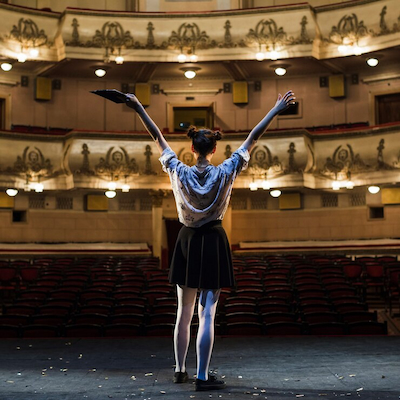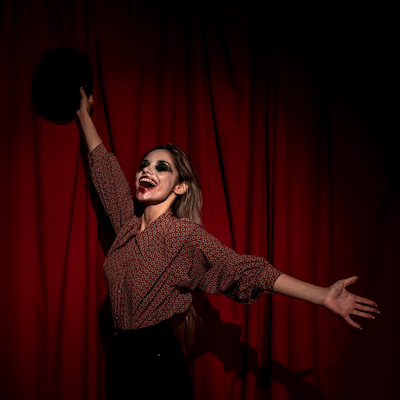
Improvisation is an artistic form of expression that allows performers to explore their creativity in real time. In both theater and dance, this practice becomes a powerful tool for freedom of expression, where artists break free from pre-set scripts and choreography. Improvisation not only offers a new dimension to performance but also challenges artists to connect more deeply with their emotions and with the audience. This instant connection is what makes improvisation so fascinating and relevant today.
Additionally, improvisation is a practice that can be applied in various situations, from live performances to rehearsals and workshops. Artists of all ages and experience levels can benefit from this approach, which encourages spontaneity and creativity. In a world often dominated by rigidity, improvisation stands out as a path to artistic freedom and innovation. This article explores how improvisation techniques work in theater and dance, their advantages, and how you can practice them in your own artistic journey.
How Improvisation Techniques Work in Theater and Dance
Improvisation techniques in theater and dance are diverse and can vary widely depending on the artist’s style and intent. In theater, improvisation often involves creating dialogues and scenes without a predefined script. Actors are encouraged to react to each other and adapt to emerging circumstances during a performance. This requires a high level of listening and presence, as each performance is unique and shaped by interactions between performers and their environment. The ability to improvise in theater fosters creativity and strengthens teamwork and adaptability.
In dance, improvisation is seen as a way to explore movement without the constraints of choreography. Dancers are encouraged to move spontaneously, allowing their emotions and thoughts to manifest through the body. This freedom of movement promotes self-expression and helps dancers connect more deeply with music and with other dancers. Dance improvisation can be influenced by various factors such as space, music, and even emotions at the moment, resulting in performances as unique as the artists themselves.
Improvisation techniques also include specific exercises that help artists warm up and prepare for performance. In theater, improvisation games are frequently used to stimulate creativity and spontaneity. These games range from simple group dynamics to complex exercises involving character and scenario creation. In dance, improvisation exercises may involve exploring different movement qualities, using props, or interacting with other dancers. These practices help artists feel more comfortable expressing themselves and promote a supportive and collaborative environment.
Finally, improvisation is a skill that can be developed through practice. Artists dedicated to exploring this form of expression often discover new aspects of their creativity and abilities. The process of improvisation is itself a constant learning journey, where artists are challenged to step out of their comfort zones and experiment with new ideas and approaches. Thus, improvisation becomes a path of self-discovery and growth in both theater and dance.

Advantages of Improvisation in Theater and Dance: Real-Time Creativity
Improvisation in theater and dance offers a series of advantages beyond simple spontaneity. One major benefit is the development of creativity. By freeing themselves from the constraints of scripts and choreography, artists have the opportunity to explore new ideas and concepts. This creative freedom can result in more authentic and impactful performances that resonate more deeply with audiences. Improvisation allows artists to connect with their emotions and express them more genuinely, creating a more engaging experience for both performer and viewer.
Another significant advantage of improvisation is the boost in confidence. When artists allow themselves to improvise, they learn to trust their abilities and instincts. This confidence is especially crucial in live performances, where unforeseen events can occur. The ability to adapt and respond quickly is a valuable skill that applies not only to the arts but also to various areas of life. Improvisation helps artists feel more secure in their choices and perform with greater authenticity.
In addition, improvisation promotes collaboration and teamwork. In theater, actors often need to support each other during an improvised scene, building a strong connection among them. This interaction enriches the performance and fosters a sense of community and support among artists. In dance, improvisation allows dancers to communicate through movement, creating a unique language that transcends words. This collaboration can result in more dynamic and exciting performances, where each artist contributes their own perspective and style.
Finally, improvisation can be a powerful tool for emotional well-being. The act of expressing oneself freely, without fear of mistakes, can be therapeutic and liberating. Many artists report that improvisation helps them cope with stress and anxiety, providing a safe space to explore their emotions. This practice is especially beneficial in uncertain times, where adaptability and reinvention are more important than ever. In short, improvisation in theater and dance not only enriches performances but also contributes to personal and emotional growth.
How to Practice Improvisation in Theater and Dance: Real-Time Creativity
Practicing improvisation in theater and dance is a journey that can be both fun and challenging. For those who want to explore this art form, here are some practical suggestions:
- Explore theater games to develop spontaneity. These games are an excellent way to warm up and relax before a performance. They help artists feel more comfortable expressing themselves and connecting with each other in a fun and light-hearted way.
- Attend improvisational dance workshops to enhance artistic expression. These workshops provide a safe environment to experiment with new movements and styles while offering opportunities to learn from other dancers and choreographers.
- Try creating improvised scenes with peers. Collaborating with other artists in improvisation can lead to surprising ideas and exciting collaborations. These sessions can be informal and focused on free exploration, allowing each artist to bring their own perspective.
- Use improvisation techniques to build confidence in performances. By allowing yourself to improvise, you develop the ability to handle unexpected situations and feel more at ease on stage. This is particularly useful in live performances, where quick adaptability is key.
- Collaborate artistically with others to enrich creativity. Working with different artists can broaden your vision and inspire you to try new approaches. The exchange of ideas and experiences leads to richer and more diverse performances.
- Incorporate elements of contemporary dance into your practices. Contemporary dance often emphasizes improvisation and movement exploration, making it a great source of inspiration. Try different styles and techniques to discover new ways of expressing yourself.
Practicing improvisation is a continuous process that requires patience and dedication. As you become more engaged with this art form, you may discover new aspects of your creativity and abilities. Improvisation is not just about what happens on stage, but also about the self-discovery journey each artist undertakes.

Did You Enjoy Exploring Improvisation in Theater and Dance?
Improvisation in theater and dance is a rich and engaging practice that offers countless opportunities for creative expression. By exploring this art form, you can develop valuable skills that extend beyond the stage and rehearsal space. The freedom of improvising enriches your performances and contributes to your personal and emotional growth.
If you’re interested in diving deeper into this practice, there’s a world of possibilities waiting for you. From workshops and training sessions to improvisational groups, the options are vast and accessible. Don’t hesitate to embark on this journey and discover the magic of improvisation in theater and dance!
Frequently Asked Questions
What is improvisation in theater and dance? Improvisation in theater and dance is when you act or move without a script. It’s about being creative in the moment.
How can improvisation help with creativity? Improvisation stimulates your mind. You learn to think fast and adapt, improving your ability to generate new ideas.
Do I need experience to improvise? No! Anyone can improvise. The important thing is to let go and have fun. Practice helps you feel more comfortable.
Can improvisation in theater and dance be rehearsed? Yes, you can rehearse improvisation! There are exercises that help you prepare, making improvising easier.
What’s the connection between improvisation and live performance? In live performance, improvisation brings emotion. You respond to the audience and the moment, making the show unique and special.

